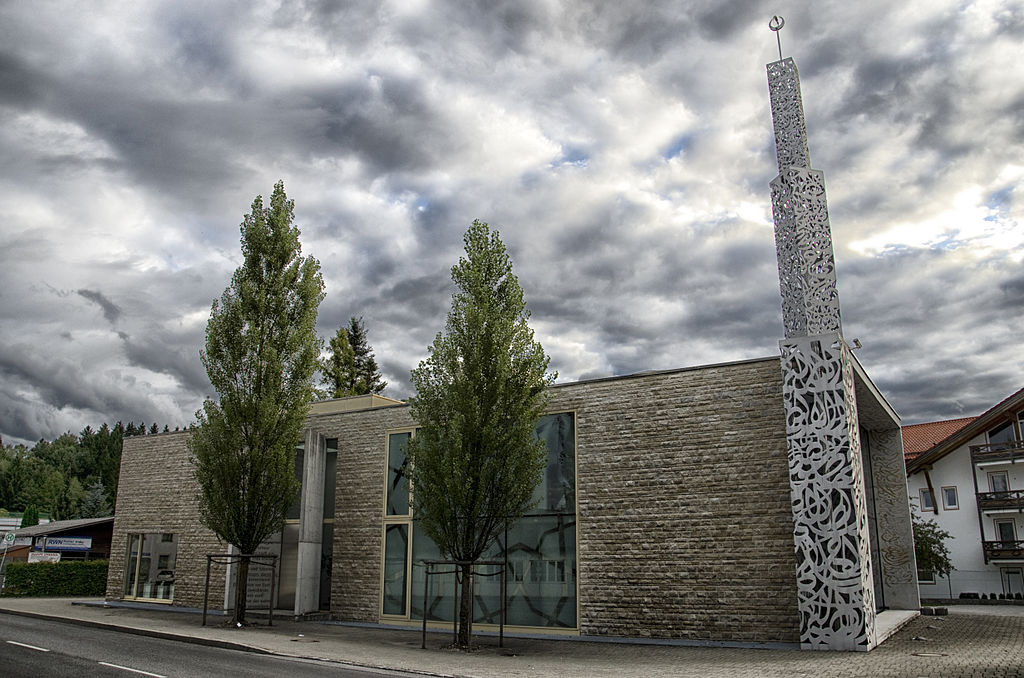Weekend reading: Mosque design revisited in the face of Islamophobia, need for greater inclusion
Photo:Â Penzberg Islamic Forum in Germany on May 4, 2014. Creative Commons 2.0
Mosques are seen as a representation of the Islamic faith and their functions have evolved over centuries in response to socio-political-economic changes. Historically, mosques fulfilled educational, social, and administrative needs. Today, the educational function of mosques is mostly limited to Quran reciting classes, while the building is only actively used during prayer times and Ramadan.
From around the middle to late twentieth century until today, mosques in both Islamic and non-Islamic countries have been vandalised and attacked, largely as a result of political motivations, retaliations, and Islamophobia.
Prominent assaults include the ones on mosques considered Islam's holiest sites: the 1969 attack on Al Aqsa mosque, and the 2016 suicide bombing outside the Prophet's mosque in Medina.
Assaults on mosques in non-Islamic countries escalated after the September 11, 2001 terrorist attacks in the United States. Vandalism and assaults against mosques and Islamic centres continue in the U.S. as well as Europe until today, arising especially after incidents of terror attacks.Â
These attacks and opposition against mosques have given local authorities, city planners, architects, and designers pause for thought as to their functions, locations, and looks, with noticeable developments in the last decade.Â
Here are 10 stories on Salaam Gateway that will connect you to the issue, and the mosques around you.Â
1. Countering 'mosquephobia' with design
Architects and urban planners argue that revisiting conventional Islamic design motifs to create functional and socially relevant mosques can counter a rising tide against the buildings in non-Islamic countries.

Photo: Muslims walk near Rijeka's new mosque May 4, 2013. The mosque, featuring minarets measuring 24 metres high, cost an estimated ten million euros ($13.1 million) to construct. This is the first mosque built in the Croatian Adriatic city since the withdrawal of the Ottoman Empire, and the third in Croatia in addition to others in Zagreb and Gunji, according to local Muslims. REUTERS/Antonio Bronic
2. Bringing mosques back to the heart of society
Architects and designers in the Middle East are creating structures in urban communities filled with life all day long instead of only during prayer times.

Photo: A group reading the Quran at Masjid al Nabawi in Medina, Saudi Arabia, on Nov 30, 2016. In the lifetime of the Prophet Mohammed (pbuh), this mosque was a hub for the then young Muslim community and performed a variety of functions including educational, social, and administrative. Abd. Halim Hadi/Shutterstock.com
3. Mosque design breaks the shackles of the past
Designers in the Middle East are pushing the boundaries of mosque architecture to create structures that are relevant and serve their function more effectively, while regulations play catch-up.

Photo: Sancaklar mosque in the Buyukcekmece district of Istanbul, Turkey, designed by award-winning Emre Arolat Architects. Aivita Arika/Shutterstock.com
4. Mosque design regulations inhibiting creativity - experts
Expanding the scope of mosques in both design and function could unleash new prospects for energy savings and aesthetic appeal, said experts at the Mosque Design and Development conference 2016 in Dubai.

Photo: Sheikh Zayed Grand Mosque in Abu Dhabi, UAE
5. 180 mln dirhams eco-retrofit of 650 Dubai mosques likely to begin this year
Work on a project to retrofit 650 Dubai mosques to make them more environmentally-friendly, estimated to cost between 90 and 180 million Emirati dirhams ($49 million), will start before the year ends. The scope of the retrofit includes measures to save electricity, solar photo-voltaic cell installation, building upgrades and sustainable water-saving solutions.

Photo: Jumeirah mosque in Dubai, United Arab Emirates
6. Mosque minarets in Malaysian state of Negeri Sembilan to become telco transmission towers
Telecommunication companies will be allowed to use mosque and surau minarets in the Malaysian state of Negeri Sembilan as telecommunication transmission towers, in a move to to attract young people and the local community to come to the mosques.

Photo: SEREMBAN, NEGERI SEMBILAN, MALAYSIA - JUNE 4, 2015: View of the Hussain Mosque / Tok Anas / Shutterstock.comÂ
7. Italy's makeshift mosques a crucial hub for Muslims' social integration
Â
With nearly 2.2 million Muslims and just one official mosque, Italy has yet to embrace this ever-growing population that mostly resides in the north of the country. Although a few Islamic centres exist, the majority of Muslims in Italy are using improvised mosques for group prayers. Dozens of abandoned warehouses, supermarkets, factories, garages, and gyms have been converted into anonymous places of worship.

Photo: A former supermarket used as makeshift place of worship, Province of Trento, Italy, 2012© Nicolo Degiorgis
8. California mosque led by women opens doors to all
The second mosque in the United States led solely by women held its inaugural service in California in April, but unlike a Los Angeles congregation that opened two years ago, the new female-led Muslim house of worship in Berkeley is open to both genders.

Photo: Worshipers sit and listen to prayers and a sermon at the Qal'bu Maryam Women's Mosque which held its first service on Good Friday, at the Starr King School for the Ministry in Berkeley, California, U.S., April 14, 2017. REUTERS/Lisa Fernandez
9. A century in the making, Athens set for first mosque since Ottoman times
The city of Athens has not had a formal mosque since it drove out occupying Ottomans in 1833, and Deputy Foreign Minister Ioannis Amanantidis told parliament last year that it was the only European capital "to be deprived of such a religious space".

Photo:Â Muslims living in Greece attend Friday prayers at the Masjid Al-Salam makeshift mosque in Athens, Greece, February 3, 2017. Picture taken February 3, 2017 REUTERS/Alkis Konstantinidis
10. U.S. anti-Muslim bias incidents increased in 2016, group says
When Masjid Al-Kareem in Providence, Rhode Island, received a threatening letter in November calling Muslims a "vile and filthy people," its members were frightened enough they asked for and got extra police protection. The 42-year-old mosque was far from alone. The letter it received was one of 2,213 anti-Muslim bias incidents in the United States last year, according to a report by the Council on American-Islamic Relations.

Photo: Imam Abdul-Latif Sackor stands outside the Islamic Center of Rhode Island, Masjid Al-Kareem Mosque in Providence, Rhode Island, U.S., May 4, 2017. Picture taken May 4, 2017. REUTERS/Brian Snyder
© SalaamGateway.com 2017 All Rights Reserved
Â
